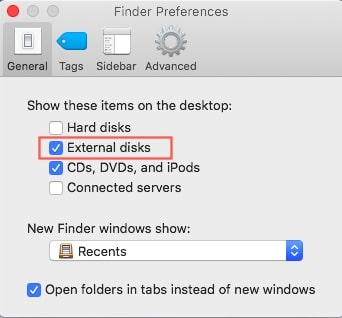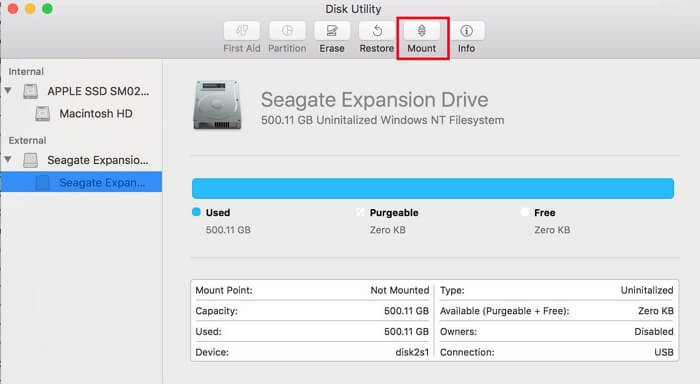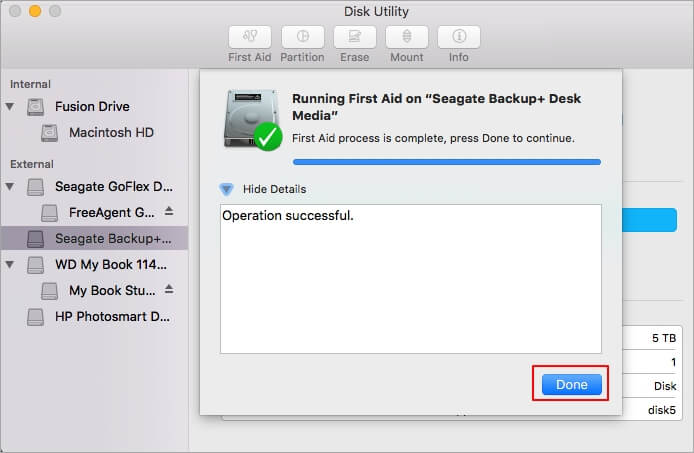Featured Articles
- 01 Windows 10 Not Detecting Hard Drive But BIOS Does
- 02 Hard Drive Not Showing Up
- 03 External Hard Drive Not Showing Up
- 04 External Hard Drive Not Showing Up on Mac
- 05 WD Hard Drive Not Showing Up
- 06 Seagate External Hard Drive Not Working/Detected
- 07 SSD Not Showing Up
- 08 M.2 Not Showing Up
- 09 NVME Drive Not Showing Up
Why Is My Seagate Hard Drive Not Showing Up Mac
Seagate external hard drives are known for their unparalleled speed and reliable storage features. With the help of Seagate external hard drives, you can save your favorite music, videos, photos, and other essential documents without any hassle. The external hard drives also come in handy while traveling. Under normal circumstances, as you connect the external hard drive to your Mac system, it automatically gets detected. However, there are many cases where Seagate is not showing up on a Mac. Before jumping into the solutions, it is essential to know the various reasons for connection failure. Some of the general reasons that result in the Seagate external hard drive not showing up on a Mac are
- Logical Failure: Some of the logical failures include virus attacks, accidental formatting, corruption, mount errors (such as com.apple.diskmanagement.disenter error 119930868), and more.
- Physical Damage: There are many cases where your Seagate external hard drive USB port might be damaged. The chances of complete hard drive damage also remain high because of overheating and water damage.
Finding the exact cause of the Seagate external hard drive not showing up on Mac can be daunting and tedious. You can follow various methods and steps to rectify the problem and use your Seagate external hard drive without hassle. It's also important to recover data from your external hard drive with professional Seagate file recovery software, and you can download this reliable hard drive recovery tool to recover lost data from your corrupted Seagate drive on a Mac.
How to Fix Seagate Not Showing Up on Mac Quickly
Sometimes the Seagate hard drive is not detected on a Mac for simple reasons. Either the connection might be lost, or your Mac system might not be able to recognize the hard drive. Here are some of the simple checks you must do to ensure that your Seagate external hard drive is not damaged from the inside.
- Re-Plug: There are many cases where you plug in your external Seagate hard drive for the first time, and it does not work. It is advised that you re-plug your external drive and check for the connection status.
- Change Another USB Port or Cable: Sometimes, faulty USB connection cables and Mac ports are the reason for Seagate external hard drive connection failure. Users are advised to check the Mac ports and change the hard drive cables.
- Test the External Hard Drive on Another Computer: To check whether the connection failure is associated with hard drive damage or the Mac system, you must test your Seagate external hard drive on another computer. If the hard drive works efficiently on another system, you must check your Mac configuration.
- Restart Your Mac: If your Mac is not reading the external hard drive with the points mentioned above, restart your Mac and reconnect the hard drive.
You can share these useful quick solutions on social media to help more Seagate users!
Even after executing all the simple solutions, if your Seagate external hard drive is not showing up on your Mac, you must check the advanced steps and methods listed below to get your hard drive working.
We also provide a video tutorial to help you fix a Seagate external hard drive that is not showing up on a Mac problem. Take a look:
- 00:26 Why the Seagate hard drive doesn't appear
- 00:35 4 quick solutions to fix Seagate disk not showing up
- 01:27 Check Finder Settings
- 01:36 Mount the Seagate hard drive
- 01:53 Check the disk errors via First Aid
- 02:12 Erase the Seagate hard drive

How to Fix Seagate External Hard Drive Not Showing Up on Mac | 4 Ways
There are various advanced steps and methods that users can follow to fix the Seagate hard drive not visible on the Mac issue. The various methods are listed below.
Method 1. Changing Preference Settings in Finder
| ⭐Quick Glance: Ensure Finder preferences are set to display external drives on the desktop and in the sidebar to rule out simple visibility issues. |
If your Seagate external drive is not visible on your Mac, you must change the preference settings in the Mac Finder. To change the preference settings, follow these steps:
Step 1. Navigate to the Finder and then click on the Sidebar option under the Preferences tab.
Step 2. Click on the 'External Disk' located in the 'Sidebar' to show Seagate external hard drives in Finder.
Step 3. Go back to the 'General Tab' and check on the 'External Disks' under 'Show These Items on the Desktop'.
Step 4. Once you follow the steps, your connected Seagate external hard drive will appear on the Mac desktop.

Method 2. Mounting External Hard Drive Using Disk Utility
| ⭐Quick Glance: Use Disk Utility to manually mount the Seagate drive, as it may be detected but not automatically mounted by macOS. |
If your Seagate external hard drive is visible in the disk utility, you can take a relaxing breath as your hard drive has no serious problem. In general, cases, mounting the Seagate hard disk makes it accessible. Mostly, the operating system automatically mounts the hard drive when you plug in the USB. However, if your Seagate hard drive is unmounted, you can follow manual procedures to mount the hard drive. Follow the steps mentioned below to force mount an external hard drive:
Step 1. Open the Disk Utility tab.
Step 2. Once the tab is opened, right-click on the external drive in Disk Utility and choose Mount. You can also click the 'Mount' button on top of the window.

Method 3. Running First Aid to Repair Seagate External Hard Drive
| ⭐Quick Glance: Run First Aid in Disk Utility to scan and fix minor disk errors that might prevent the drive from showing up properly. |
If your Seagate external drive is not showing up on Mac even after mounting the hard drive manually using Disk Utility, your hard drive could have disk errors. To the relief, you can repair your Seagate external hard drive using the native disk repair tool known as 'First Aid'. Follow the steps to repair the hard drive using First Aid.
Step 1. Navigate to the Launchpad icon on the Dock and search for the Other Option.
Step 2. Find Disk Utility and open it.
Step 3. Select the unmountable Seagate external hard drive and choose First Aid at the top.
Step 4. Click on Run to repair the hard drive.

Method 4. Reformatting Seagate External Hard Drive to a Mac-Supported File System
| ⭐Quick Glance: If the drive remains unrecognized, reformat it to APFS or Mac OS Extended (Journaled) to ensure full compatibility with macOS. |
Before applying this method, you should know that formatting the Seagate drive will remove everything on it; back up your disk in advance or apply recovery software if important files are deleted by mistake.
Even if First Aid fails to repair the Seagate external hard drive, it is advised that you reformat the external hard drive. To reformat the external hard drive to a Mac-supported file system, follow these steps:
Step 1. Connect the Seagate external hard drive and find the Disk Utility option from the Launchpad icon.
Step 2. Choose your connected Seagate hard drive and click on the Erase option.
Step 3. Edit the hard drive name and select a format that would work with your Mac system.

Step 4. Once you have selected the format system, click on Erase button.
Step 5. Click on Done and finish the process.
However, before reformatting the Seagate external hard drive, users are advised to back up their crucial data to avoid any complications.
How to Recover Data from Seagate Hard Disks on Mac
Some of the connection failures of a Seagate external hard drive result in data loss. To the rescue, the EaseUS Data Recovery Wizard for Mac allows users to back up all their important data. The data recovery software by EaseUS supports different kinds of recoveries, such as recovering a formatted hard drive on a Mac, restoring from an OS crash , raw disk, and more. Mac users can recover more than 250 different types of files with the help of EaseUS Data Recovery Wizard. To recover data from the Seagate external hard drive, users have to follow three simple steps, and the recovery process will begin.
Step 1. Search for lost files
Correctly connect your external hard drive to your Mac. Launch EaseUS Data Recovery Wizard for Mac, and select the external hard drive. Then, click "Search for lost files" to find lost/deleted files on your external devices.

Step 2. Filter and find lost files
After the scan, all file types will be presented in the left panel. Select the file type to find wanted files on your external devices.

Step 3. Preview and recover
Click the file and preview it. Then, select the files you want to recover and click the "Recover" button. You can save your data to local and cloud drives.

Feel free to share this Seagate hard disk recovery method on social media and help more readers!
Conclusion
There are multiple reasons that can lead to the Seagate external hard drive not showing up on Mac. However, there are ample ways to fix the connection failure problem. If your Seagate external hard drive is not showing up on Mac, you can follow any of the methods listed in the article. If you lose the data in the connection process, you can use the EaseUS Data Recovery Wizard for Mac and get back your important data.
Seagate Not Showing Up on MacBook FAQs
Check the following frequently asked questions and learn more about this Seagate hard disk detection problem:
1. Why is my Seagate external hard disk not responding on my Mac?
Make sure you have the cable you are using to connect the Seagate external hard drive and your Mac is not damaged, and you should check the USB ports as well. If all the physical connections are performing well, consider logical damage that causes your drive not to show up on the Mac.
2. Why does my MacBook not detect my Seagate hard disk?
Sometimes, it's possible that your Seagate hard disk is using the file system that a MacBook cannot recognize. There are also some hardware issues, or logical errors can cause a Seagate drive not to be detected by a Mac.
3. How do I fix Mac not mounting Seagate external hard drive?
You can manually mount your Seagate external hard drive in Disk Utility, or you can run First Aid to fix some disk issues that cause your Seagate drive not to mount normally.
Was This Page Helpful?
Dany is an editor of EaseUS who lives and works in Chengdu, China. She focuses on writing articles about data recovery on Mac devices and PCs. She is devoted to improving her writing skills and enriching her professional knowledge. Dany also enjoys reading detective novels in her spare time.
Jean is recognized as one of the most professional writers in EaseUS. She has kept improving her writing skills over the past 10 years and helped millions of her readers solve their tech problems on PC, Mac, and iOS devices.
Related Articles
-
Recover Data From FileVault Hard Drive [All You Should Know]
![author icon]() Finley/Dec 12, 2025
Finley/Dec 12, 2025 -
How to Permanently Delete Downloads on Mac to Clear Up Space [macOS Ventura/Monterey/Big Sur]
![author icon]() Jaden/Dec 12, 2025
Jaden/Dec 12, 2025 -
How to Recover Permanently Deleted Files Mac (2025)
![author icon]() Jean/Dec 15, 2025
Jean/Dec 15, 2025 -
Recover Lost Data After Migration Assistant Interruption on Mac
![author icon]() Brithny/Dec 12, 2025
Brithny/Dec 12, 2025
